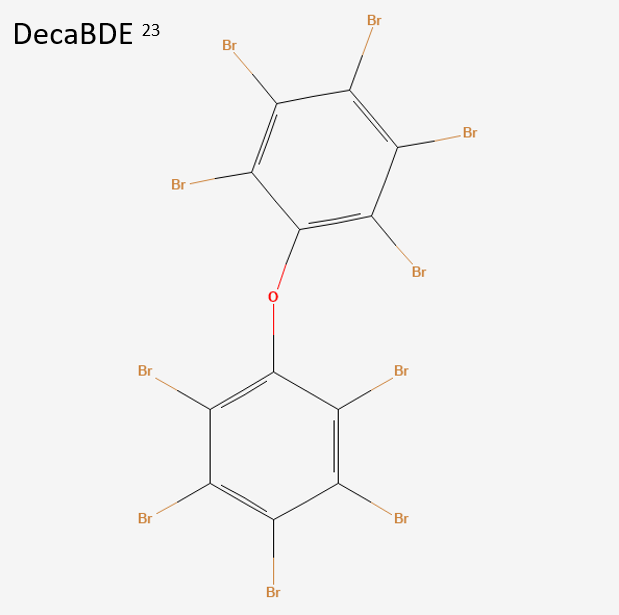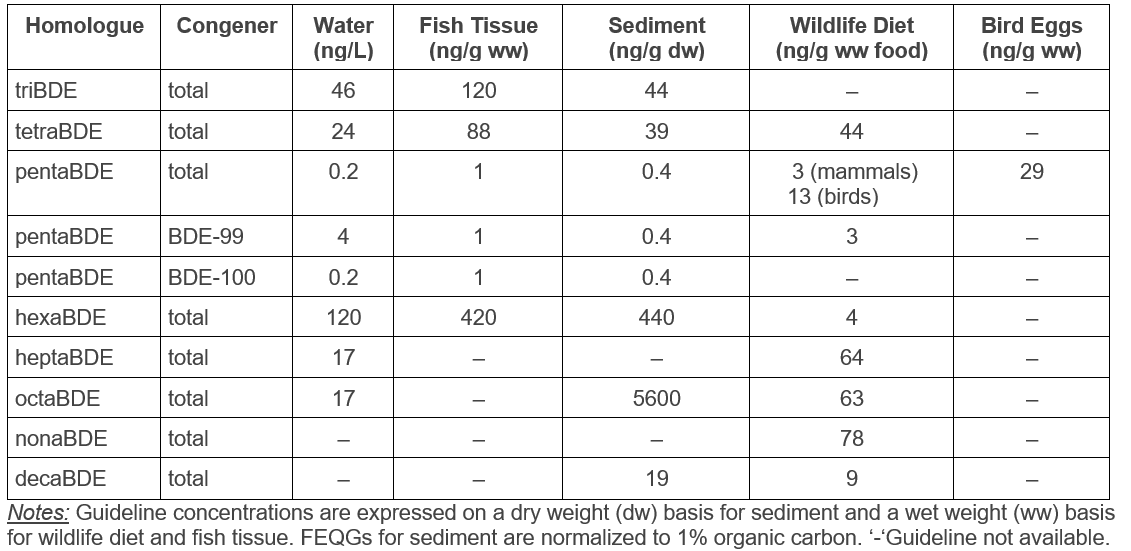SedimentPBDEs (µg/kg dry weight)
|
MusselsPBDEs (µg/kg wet weight)
|
|
|---|---|---|
|
|
North |
|
| South |
What are they?
Polybrominated diphenyl ethers (PBDEs) are brominated flame retardants used in manufactured materials. PBDEs were never manufactured in Canada and are no longer used but were historically imported in finished products such as furniture, electronics, and vehicles. The total historical production of all PBDEs from 1970 to 2005 has been estimated at between 1.3 and 1.5 million tonnes.1
PBDEs can be classified by the number of bromine atoms they contain. Octa and deca-BDEs (eight and 10 bromine atoms, respectively) are mostly found in plastics and electronic housings, while penta-BDEs (five bromine atoms) are used primarily in polyurethane foams and textiles.2

How do they get into the ocean?
The major pathways by which PBDEs enter the marine environment are likely wastewater treatment plants and landfill runoff. In addition, combustion of waste containing PBDEs can introduce PBDEs into the atmosphere 3, and they can subsequently be deposited in the marine environment.
FACT: Although there are 209 different PBDE congeners, just one – BDE-209, contributes to ~ 80% of the total PBDEs found in sediment from the Strait of Georgia.4 This form of the chemical is unstable and can break down in a way that makes it easier to move into aquatic food webs.
PBDEs have been detected in municipal wastewater discharges in the Lower Mainland and Okanagan.5 PBDEs can also travel long distances through the atmosphere, and recent studies indicate that non-North American sources make significant contributions of PBDEs to coastal British Columbia air.6 PBDEs are persistent and bioaccumulate in marine food webs 7, though decreases in PBDE levels have been documented in both seabird and marine mammal tissues since restrictions on use, sale, and import of PBDEs were implemented in Canada.8,9
Are they a problem?
Brominated flame retardants are known to have toxic effects in terrestrial and aquatic organisms. PBDEs can disrupt hormones, and exposure can lead to long-term developmental effects on neurological, reproductive, and immune systems.3 The most widely used chemical in this group, deca-BDE, is also suspected to cause cancer.
PBDEs biomagnify (increase in concentration) in food webs, exposing high trophic level species to levels that may cause health effects.10 In mammals, PBDEs can also be transferred from mother to young via the placenta 11,12 and via lactation 13,14, creating an exposure route for developing young. In harbour seals, PBDEs were found to impact thyroid hormone expression as well as the immune system.15
What is being done?
In Canada, regulations implemented in 2008 prohibited the manufacture of all PBDEs and restricted the use and sale of penta-BDE in commercial mixtures.5 As of 2016, prohibitions on use and sale were extended to all PBDEs (including deca-BDE) and products containing them, except manufactured items.16
Penta and octa-BDEs were banned by the European Union (EU) in 2004 and have been listed as persistent organic pollutants (POPs) under the Stockholm Convention. Deca-BDE is the most widely used PBDE globally and is still produced in the United States and Europe. 3 The EU announced plans to regulate deca-BDE beginning in March 2019, with deca-BDE products produced prior to this being exempt.17
Canadian Federal Environmental Quality Guidelines (FEQGs) have been developed for PBDEs for water (protective of aquatic life), sediment (protective of sediment-dwelling organisms and pelagic animals that bioaccumulate PBDEs from sediment), fish tissue (protective of fish), wildlife diet (protective of mammals), and bird eggs (protective of birds). FEQGs are based on different PBDE groupings, rather than total PBDE concentrations (Table 1).
In addition, in 2021 British Columbia adopted a lower working sediment quality guideline for total PBDEs (1 μg/kg dw) considered protective of killer whales, based on the work of Alava et al., 2016.22 This is significant, as previous sediment quality guidelines for PBDEs, as well as most current sediment quality guidelines for other contaminants of concern to marine biota, are only protective of invertebrates or organisms at the bottom of the marine food web.
Table 1. Federal Environmental Quality Guidelines for PBDEs 18
What can we do?
As individuals and organizations, we can:
- Learn more about PBDEs and other brominated flame retardants using the resource links below
- Recycle and dispose of waste responsibly and according to local guidelines
- Avoid using products that contain PBDEs and other contaminants of concern. The US EPA’s Safer Choice program identifies products that are safer for humans and the environment and can be used as a reference to check product ingredients.19,20 The Green Science Policy Institute also provides information regarding consumer choices.21
More Information?
1 Olisah C, Okoh OO, Okoh AI. 2018. A bibliometric analysis of investigation of polybrominated diphenyl ethers (PBDEs) in biological and environmental matrices from 1992 – 2018. Heliyon 4: e00964. doi: 10.1016/j.heliyon.2018.e00964
2 Vonderheide AP, Mueller KE, Meija, J, Welsh G. 2008. Polybrominated diphenyl ethers: Causes for concern and knowledge gaps regarding environmental distribution, fate and toxicity. Science of the Total Environment 400: 425-436.
3 Akortia E, Okonkwo JO, Lupankwa M, Osae SD, Daso AP, Olukunle OI, Chaudhary A. 2016. A review of sources, levels, and toxicity of polybrominated diphenyl ethers (PBDEs) and their transformation and transport in various environmental compartments. Environmental Reviews 24: 253-273.
4 Ross PS, Couillard CM, Ikonomou MG, Johannessen SC, Lebeuf M, Macdonald RW, Tomy GT. 2009. Large and growing environmental reservoirs of Deca-BDE present an emerging health risk for fish and marine mammals. Marine Pollution Bulletin 58: 7-10.
5 Garrett C, Ross PS. 2010. Recovering Resident Killer Whales: A Guide to Contaminant Sources, Mitigation, and Regulations in British Columbia. Canadian Technical Report of Fisheries and Aquatic Sciences 2894: xiii + 224 p.
6 Noël M, Dangerfield N, Hourston RAS, Belzer W, Shaw P, Yunker MB, Ross PS. 2009. Do trans-Pacific air masses deliver PBDEs to coastal British Columbia, Canada? Environmental Pollution 157:3404–3412.
7 de Wit CA. 2002. An overview of brominated flame retardants in the environment. Chemosphere 46: 583-624.
8 Miller A, Elliott JE, Elliott KH, Guigueno MF, Wilson LK, Lee S, Idrissi A. 2015. Brominated flame retardant trends in aquatic birds from the Salish Sea region of the west coast of North America, including a mini-review of recent trends in marine and estuarine birds. Science of the Total Environment 502: 60-69.
9 Ross PS, Noël M, Lambourn D, Dangerfield N, Calambokidis J, Jeffries S. 2013. Declining concentrations of persistent PCBs, PBDEs, PCDEs, and PCNs in harbor seals (Phoca vitulina) from the Salish Sea. Progress in Oceanography 115: 160-170.
10 Alava JJ, Ross PS, Gobas FAPC. 2016. Food web bioaccumulation model for resident killer whales from the northeastern Pacific Ocean as a tool for the derivation of PBDE-sediment quality guidelines. Archives of Environmental Contamination and Toxicology 70: 155-168.
11 Brown TM, Ross PS, Reimer KJ. 2016. Transplacental transfer of polychlorinated biphenyls, polybrominated diphenylethers, and organochlorine pesticides in ringed seals (Pusa hispida). Archives of Environmental Contamination and Toxicology 70: 20-27.
12 Desforges JPW, Ross PS, Loseto LL. 2012. Transplacental transfer of polychlorinated biphenyls and polybrominated diphenyl ethers in arctic beluga whales (Delphinapterus leucas). Environmental Toxicology and Chemistry 31: 296-300.
13 Wolkers H, Hammill MO, van Bavel B. 2006. Tissue-specific accumulation and lactational transfer of polychlorinated biphenyls, chlorinated pesticides, and brominated flame retardants in hooded seals (Cistophora cristata) from the Gulf of St. Lawrence: Applications for monitoring. Environmental Pollution 142: 476-486.
14 Frouin H, Lebeuf M, Hammill M, Fournier M. 2012. Transfer of PBDEs and chlorinated POPs from mother to pup during lactation in harp seals Phoca groenlandica. Science of the Total Environment 417-418: 98-107.
15 Frouin H, Lebeuf M, Hammill M, Masson S, Fournier M. 2010. Effects of individual polybrominated diphenyl either (PBDE) congeners on harbour seal immune cells in vitro. Marine Pollution Bulletin 60: 291-298.
16 Health Canada. 2017. DecaBDE (Decabromodiphenyl Ether). Available at: https://www.canada.ca/en/health-canada/services/chemical-substances/fact-sheets/chemicals-glance/decabde.html.
17 Official Journal of the European Union. 2017. Commission Regulation (EU) 2017/227. Amending Annex XVII to Regulation (EC) No 1907/2006 of the European Parliament and of the Council concerning the Registration, Evaluation, Authorisation and Restriction of Chemicals (REACH) as regards bis(pentabromophenyl)ether. Available at: http://eur-lex.europa.eu/legal-content/EN/TXT/PDF/?uri=CELEX:32017R0227&from=EN
18 Environment and Climate Change Canada (ECCC). 2013. Canadian Environmental Protection Act, 1999 Federal Environmental Quality Guidelines: Polybrominated diphenyl ethers (PBDEs). Available at: Canadian Environmental Protection Act, 1999
19 United States Environmental Protection Agency (US EPA). 2018. Safer Choice. Available at: https://www.epa.gov/saferchoice
20 United States Environmental Protection Agency (US EPA). 2014. An Alternatives Assessment for the Flame Retardant Decabromodiphenyl ether (DecaBDE). Available at: https://www.epa.gov/sites/production/files/2014-05/documents/decabde_final.pdf
21 Green Science Policy Institute. 2017. Flame Retardants. Available at: http://www.sixclasses.org/videos/flame-retardants
22 British Columbia Ministry of Environment and Climate Change Strategy. 2021. Working Water Quality Guidelines: Aquatic Life, Wildlife & Agriculture. Water Quality Guideline Series, WQG-08. Prov. B.C., Victoria B.C. Available at: bc_env_working_water_quality_guidelines.pdf (gov.bc.ca)
23 PubChem Identifier: CID 14410 URL: Decabromodiphenyl oxide | C12Br10O – PubChem (nih.gov)